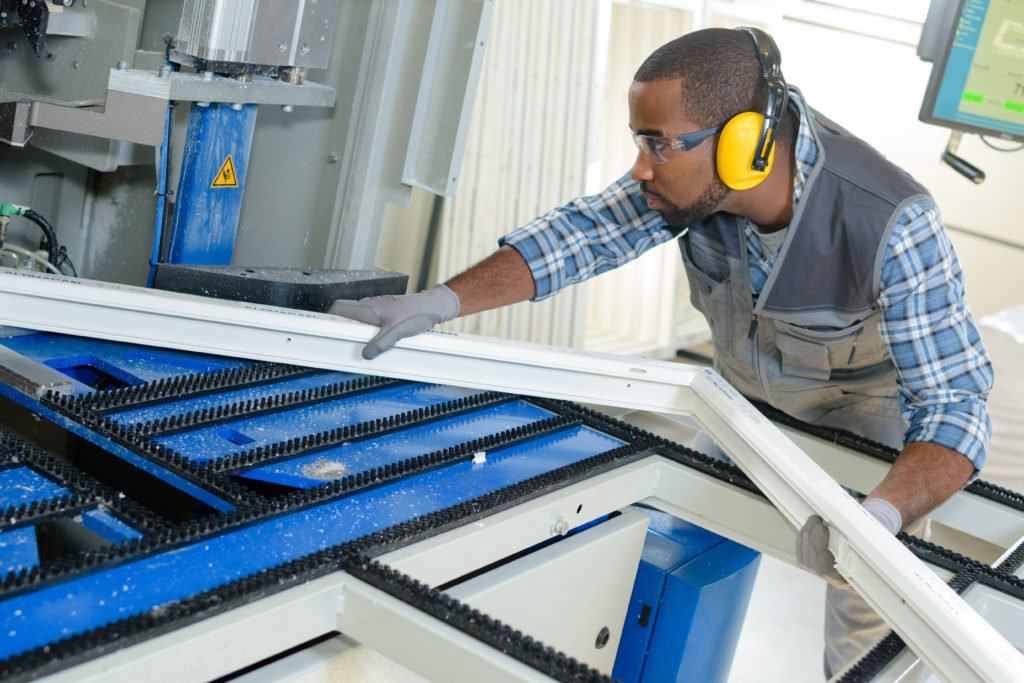Industrial Hygiene Services Prevent Health Hazards for the Plastics Industry
The U.S. plastics industry employed just under one million workers in 2020 and continues to grow and expand. Leading the way in production and employment are Texas, Ohio, and California. In addition to environmental and safety issues, health hazards associated with the production of plastic products are a concern and should be recognized.
Man manufacturing upvc frame
Types and Characteristics of Commonly Used Plastics
The major types of plastic are classified as thermosets, elastomers, and thermoplastics. Thermosets are heated and require a curing agent which results in a permanent form that cannot be reground and reused. Elastomers can return to the original shape and size after deformation but are not formed by the same process as rubber. Thermoplastic polymers (resins) are widely used because they can be re-ground and re-molded; thereby eliminating waste and reducing production costs.
The most common thermoplastic polymers in use include:
Polyethylene
Polypropylene
Polyvinyl chloride (PVC)
Polystyrene
Acrylonitrile-butadiene- styrene (ABS)
Styrene acrylonitrile
Styrene-butadiene copolymers
Prior to molding, thermoplastic resins are mostly inert and present a low health risk except for any unreacted residual monomers, or molecules that bond together to form the polymer structure. A striking example of the effects of overexposure to resin dusts occurred in the 1970s when several workers who handled PVC resins were diagnosed with angiosarcoma, a rare liver disease. A significant reduction in exposure that lowered the risk for the development of disease was achieved when controls were applied to reduce the amount of unreacted monomer present in PVC resins. The levels went from as high as 1 percent to 0.001 percent.
Other sources of exposure can occur when the additives are combined with the resins to produce specific properties for the end product. Ideally, this occurs in a closed-looped system that exhausts the dust and minimizes exposure. In smaller operations, this is often not the case.
Additives are added to modify the properties of resins, aid in the molding process, and provide color. Common additives include flame retardants, antioxidants, blowing agents, optical brighteners, antistatic agents, UV light absorbers, fillers, solvents, curing agents, and reinforcements. Nearly 2,500 different chemicals are used in the production of additives. Additive compounds that commonly pose risks include:
Phthalates in plasticizers
Antimony, boron, bromine compounds in flame retardants
Hydrochlorofluorocarbons (HCFCs) and azodicarbonamide in blowing agents
Toxic heavy metal compounds (lead, cadmium, and chromium) in colorants
Thermal degradation products from organic colorants that are used as alternatives to metal compound colorants
Hazards During the Molding Process
The next phase where hazards exist is during the molding process, when the mold is released, and during purging and maintenance. Purging is performed whenever there is a resin or color change, or maintenance is needed on equipment. During purging, higher than usual molding temperatures are needed to clear the equipment of residue, and smoke is produced that may contain thermal degradation products from the resin and additives.
To protect workers, it is necessary to provide adequate exhaust ventilation in and around molding lines. If ventilation controls are inadequate in controlling dust levels during mixing, mists and vapors during mold release, or smoke generated during purging, occupational exposures should be assessed.
Sampling Strategy
The starting point for designing a good strategy for sampling is to review Safety Data Sheet (SDS) information for the resin and additives used in the process to determine regulated components and thermal degradation products. Some examples of constituents that are commonly assessed during personal sampling include the following:
Butane- contained in n, and acrolein in polypropylene resins
Hydrogen chloride in PVC resins
Styrene contained in polystyrene
Phenols and butadiene contained in ABS resins
Nuisance dust
When results from sampling are available, it can be determined if exposures have exceeded occupational exposure limits (OELs) established by the Occupational Safety and Health Administration (OSHA), the American Conference of Governmental Industrial Hygienists (ACGIH), and the National Institute of Occupational Health and Safety (NIOSH). If exposures exceed OELs, the proper respiratory protection can be provided to the workers in accordance with the OSHA Respiratory Protection standard but should be used only as a stopgap before control measures can be implemented and tested for effectiveness.
Noise Exposure
Another health hazard to consider in the plastics industry is noise exposure. It is common for noise exposures to exceed the OSHA Action Level (AL), which is 85 “A”-weighted decibels (85 dB(A) for hearing conservation.
In a typical operation, there is a high density of noise sources such as motors, fans, hydraulic pumps, and other equipment. Depending upon the size of the operation, exposures can even exceed the Permissible Exposure Limit (PEL) of 90 dB(A), and when that occurs, engineering and/or administrative controls are needed to reduce exposures.
Personal noise exposures are easily assessed utilizing calibrated noise dosimeters that record and average sound levels throughout the work period. The data logged is then used to determine the 8-hour time-weighted average exposure which can then be compared with the AL and PEL.
Further Information
Cornerstone serves clients that produce plastic products or packaging used by the food and beverage industry, health and beauty products, and a variety of consumer goods. Our Health and Safety department can perform a Personal Exposure Assessment to observe operations, job tasks, and work practices for air, noise, and ergonomic safety. Our experts provide reports of risks, prioritize areas for changes, and recommend control measures. Contact Cornerstone at info@corner-enviro.com or on our website for more information.
Mary Dunlap CIH, is a Senior Industrial Health and Safety Specialist and Certified Industrial Hygienist. She works with Cornerstone’s clients to develop exposure assessment strategies tailored for their work environments. She regularly performs ergonomic assessments using a variety of OHA and NIOSH tools to rate severity of risk for work related to musculoskeletal disorders.
References:
Recognition of Health Hazards in Industries – Second Edition, William A. Burgess
The Hazards of Plastic Injection Molding and Recommended Engineering Safety Controls – Sentry Air Systems




